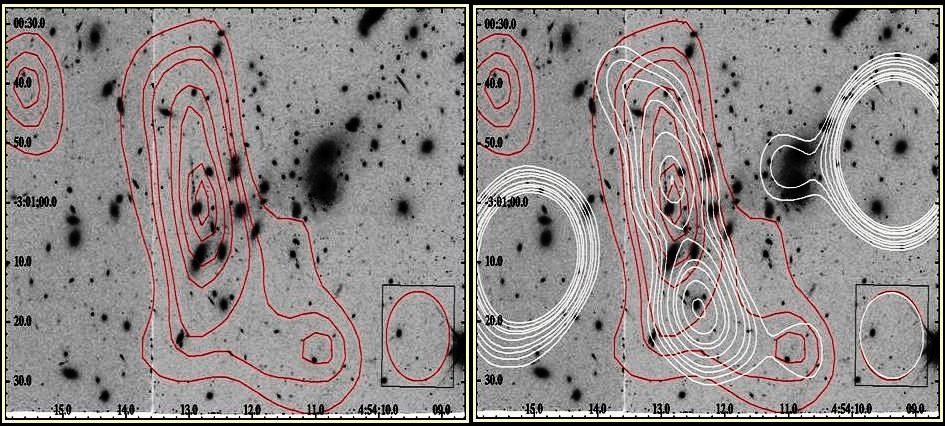Daily Image
11-12-2006Field of Dreams
| Submitter: | Michael Garrett |
| Description: | One of the most important developments in astronomy over the last decade has been the discovery of a large population of very distant, dust obscured Galaxies that are almost invisible at all wavelengths except the sub-mm (Far-Infrared) and radio domains. Known as Sub-mm Galaxies (SMGs), only the most massive and luminous examples can be detected in deep radio continuum surveys. However, the overall SMG source population is expected to be dominated by much fainter and significantly less massive galaxies. The idea of detecting these objects using current radio telescopes has been nothing more than a pipe dream, awaiting the arrival of next generation instruments, such as LOFAR and the SKA. Recently some progress has been made by using massive foreground galaxy clusters as gravitational lenses - permitting some small parts of the distant background sky to be seen as though they were under the view of a giant and powerful magnifying glass! The pictures above show such a piece of sky - a SCUBA sub-mm contour map (left) is superimposed on an HST image of a field centred on a massive (foreground) cluster, MS0451. The sub-mm & indeed radio emission is produced by a distant interacting SMG system that is then magnified by a factor ~ 50 by the cluster. The picture to the right shows the same image again, but with a VLA 1.4 GHz radio map (white contours) superimposed. Unusually both the radio and sub-mm emission emission are clearly resolved and extend over 1 arcminute across the sky - the overall morphology is strikingly similar and quite bizarre for such a faint system. The other compact radio sources (to the right and left of the sub-mm emission) are probably active galaxies associated with nearby galaxy cluster members. The HST image also reveals some of the lensed systems that are probably responsible for the sub-mm and radio emission - in particular multiply imaged, stretched and distorted arc-like features can be seen to the north-east of the peak in the sub-mm/radio emission. This is only the second case of multiple imaging of distant radio sources by massive foreground clusters and provides us with a glimpse into the nature of these systems - new instruments such as LOFAR and the SKA will eventually detect hundreds of millions of these intrinsically faint sources. This work forms part of the PhD thesis study of Alicia Berciano Alba (JIVE/Kaptenyn) and is to be published in Astronomy & Astrophysics (see http://arxiv.org/abs/astro-ph/0603466 and astro-ph/0501095 for more details). |
| Copyright: | JIVE/Kapteyn |
| Tweet |  |
